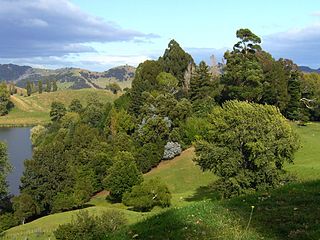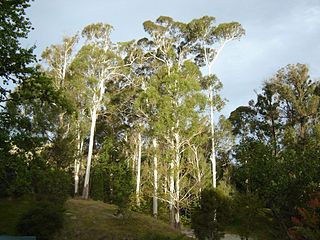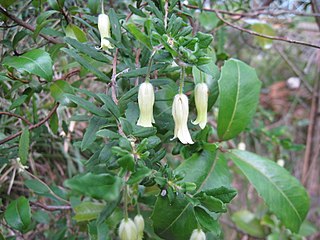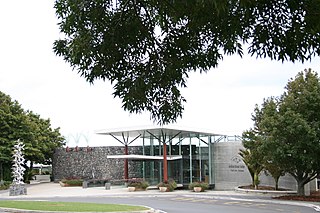
Feijoa sellowiana also known as Acca sellowiana (O.Berg) Burret, is a species of flowering plant in the myrtle family, Myrtaceae. It is native to the highlands of southern Brazil, eastern Paraguay, Uruguay, and northern Argentina. Feijoa are also common in gardens of New Zealand. It is widely cultivated as an ornamental tree and for its fruit. Common names include feijoa, pineapple guava and guavasteen, although it is not a true guava. It is an evergreen shrub or small tree, 1–7 metres (3.3–23.0 ft) in height.
The Royal New Zealand Institute of Horticulture (RNZIH) is a horticultural society in New Zealand.

The Reeves-Reed Arboretum is a nonprofit arboretum and garden located at 165 Hobart Avenue in Summit, Union County, New Jersey, United States. It is the only arboretum in Union County. A popular wedding spot, the arboretum grounds are open daily from dawn till dusk, free of charge.
The following lists events that happened during 1908 in New Zealand.
This is an alphabetical index of articles related to gardening.

Hamilton Gardens is a public garden park in the south of Hamilton owned and managed by Hamilton City Council in New Zealand. The 54-hectare park is based on the banks of the Waikato River and includes enclosed gardens, open lawns, a lake, a nursery, a convention centre and the Hamilton East Cemetery. It is the Waikato region's most popular visitor attraction, attracting more than 1 million people and hosting more than 2,000 events a year.

Hackfalls Arboretum is an arboretum in New Zealand. It was founded in the 1950s by Bob Berry. It is part of Hackfalls Station, a sheep and cattle farm of about 10 square kilometres, owned by the Berry family. The farm is in Tiniroto, a tiny village in the eastern part of the North Island, between Gisborne (town) and Wairoa.
The arboretum covers 0.56 km2, along the borders of two lakes, and has about 3,500 species of trees and shrubs. It includes many different oaks "spaced in rolling pastureland, allowing each to develop fully, and limbed up to enable grass to grow underneath". The most important part of the collection is about 50 different taxa of Mexican oaks.

Eastwoodhill is the national arboretum of New Zealand. It covers 131 hectares (1.31 km2) and is located 35 km northwest of Gisborne, in the hill country of Ngatapa. It was founded in 1910 by William Douglas Cook. Cook's life work would become the creation of a giant collection of Northern Hemisphere temperate climate zone trees in New Zealand – a dream that would eventually cost him all his money – buying and importing thousands of trees from New Zealand and British nurseries.

Billardiera scandens, commonly known as apple berry or apple dumpling, is a small shrub or twining plant of the Pittosporaceae family which occurs in forests in the coastal and tableland areas of all states and territories in Australia, apart from the Northern Territory and Western Australia. It has a silky touch and appearance that becomes more brittle as the dense growth matures. The inflorescence consists of single or paired yellow flowers, pink-tinged yellow sepals and bright yellow petals and is attached to a hairy drooping peduncle. The summer flush produces fruit of oblong berries up to 30 mm long, initially green in colour and covered in fine hair - somewhat akin to a tiny kiwifruit in appearance.

Agapanthus praecox is a popular garden plant around the world, especially in Mediterranean climates. It is native to the Kwa-Zulu Natal and Western Cape provinces of South Africa. Local names include agapant, bloulelie, isicakathi and ubani. Most of the cultivated plants of the genus Agapanthus are hybrids or cultivars of this species. It is divided into three subspecies: subsp.praecox, subsp. orientalis and subsp. minimus.
William Douglas Cook was the founder of Eastwoodhill Arboretum, now the national arboretum of New Zealand, and one of the founders of Pukeiti, a rhododendron garden, close to New Plymouth. He was a "plantsman with the soul of a poet and the vision of a philosopher".
Lady Anne Sophia Berry was an English-New Zealand horticulturist who founded Rosemoor Garden. She offered the garden to the Royal Horticultural Society in 1988. In 1990 she married Bob Berry and went to live on his farm at Tiniroto, Gisborne, New Zealand. She then created the Homestead Garden of Hackfalls Arboretum.

Auckland Botanic Gardens is a botanical garden in the New Zealand city of Auckland. It is located in the suburb of Manurewa, in the Manurewa Local Board Area. The garden covers 64 hectares, and holds more than 10,000 plants.

Bason Botanic Gardens are located in Whanganui in the Manawatū District of New Zealand. They have been rated as a Garden of Significance by the New Zealand Gardens Trust and offer six themed areas, including one of the most extensive public-garden orchid collections in the country, and the conservatory architecture is considered unique. Much of the development work is conducted by the Bason Botanic Gardens Trust, which collaborates with the City Council.

Originating from South Africa, Agapanthus—specifically Agapanthus praecox and its cultivars—were brought to New Zealand and later became a popular and common invasive species garden plant.

Roderick Leon Bieleski was a New Zealand plant physiologist. As a botanist and horticulturist, his research focussed on understanding the factors that affected the behaviour of plants, in particular horticultural crops. His work had practical relevance to farmers and orchardists in building their understanding of these factors and taking account of them while making a living from growing and harvesting plants. He received many honours and awards, culminating in being appointed Member of the New Zealand Order of Merit (MNZM) in 2010.

Lonicera × bella, known as Bell's honeysuckle and showy fly honeysuckle, is a hybrid species of flowering plant in the family Caprifoliaceae. It was first described by Hermann Zabel in 1889. Zabel reported that he grew it in cultivation from seeds obtained from a plant of Lonicera morrowii, but that its appearance suggested the influence of L. tatarica. It has escaped from cultivation and become an aggressive invasive species in central and eastern parts of the United States.
Nancy Margaret Tichborne was a New Zealand watercolour artist. She specialised in paintings of flowers; her work has appeared on calendars, diaries, cards and postage stamps in New Zealand and internationally.

Sonchus kirkii, also known as New Zealand sow thistle, or shore puha is a herb in the Asteraceae family. It grows in coastal New Zealand.












